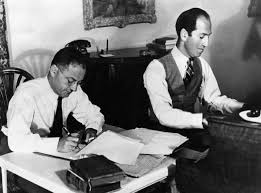A NOUVEAU HOUSE FOR THE NOUVEAU RICHE - NEW YORK'S OPERA WARS
If, like me, you were a late '80s to early '90s teen, you know that the mall was the place everyone went to to socialize. You teased and hair sprayed your permed hair, put on your hypercolor shirt and acid washed jeans to camp out at the food court and gossip about other kids at school. Imagine that, only with expensive gowns, jewels, and tail coats worn by millionaires attending the opera. The opera was the backbone of the social season. If you have read Edith Wharton's The Age of Innocence you know that the opera is where Newland Archer and May Welland make their plans to announce their engagement. And if you've seen Season 1 of The Gilded Age you know that being asked to the opera by someone from society was your key to social success. (Good riddance Mr. Raikes!) Opera had always been viewed at the Academy of Music until the nouveau riche, tired of exclusion, built a nouveau house of their own.
The opera was crucial to New York City society. Opera was a way of bringing European culture to America and thus, the nobs could pat themself on the back that they knew what was what. Established in 1854, The Academy seated 4,000 people and featured 18 boxes. Boxes were owned by Old Guard families who passed them down by generations. At intermission ladies remained in their boxes and gentlemen came to see them to pay salutations. Young men visited their young lady of interest to show their intentions. With opera glasses fixed firmly toward the boxes (and not the actual opera being performed), patrons could gossip about who wasn't present, who was present (and probably shouldn't have been) and who was sitting with whom.
By 1883 the arrivestes were firmly established, and newer and richer families kept arriving. The up-starts felt they deserved a place to show off their money and cultured selves, and added their names to the waitlist for Academy boxes. The cruel trick there was, again, boxes were inherited, meaning no boxes would ever be open. So, okay, build more boxes, right? No said the nobs. Academy member August Belmont (father of Alva Vanderbilt's second husband Oliver) offered to fund the building of 26 more boxes below the original 18. If that ain't a genius power move ; that'll show him where they rank.
So, the swells pulled a rich, white, privileged version of "if you don't play nice, I'm taking my toys and leaving!" They pooled $1.7 million, hired architect J C Cady, and commissioned the Metropolitan Opera House. The new house boasted more boxes, gilding, and gas lit crystal fixtures. The building's inside mimicked a jewelry box with red velvet drapes and seating - sending the message that its patrons were precious jewels worth lots of money. They hired Christine Nilsson to perform Faust, who sang, aptly enough, The Jewel Song and earned a 5-minute standing ovation.
That opening night of October 22nd, 1883 signaled the beginning of the end of the Old Guard's hold on society. Choosing a house meant choosing a faction: Academy of Music = old - Metropolitan = new. Some patrons bought boxes at the Met to see who would be victorious ; Mrs Astor was "out of town" and did not attend. The Met's opening night was a critical success, though the New York Times frowned upon the acoustics saying one couldn't hear very well in the upper seats. Perhaps that wasn't criticism, but commentary.
SOURCES :
Cooper, Anderson / Howe, Katherine ~ Vanderbilt : The Rise and Fall of an American Dynasty .
Evans, Elinor. "The War of the Operas." Town & Country, 29 October 2023.
Rathe, Adam. "Is The Gilded Age's Opera War Based on a True Story?" Town & Country, 5 November 2023.
Raymond, Carl, host. "Divas Diamonds, Drama : The Opening of the Metropolitan Opera 1883." The Gilded Gentleman, Episode 2, Bowery Boys Media, 6 December 2021.
FURTHER MEDIA :
PODCASTS:
Meyers, Tom / Young, Greg, hosts. "The Brooklyn Academy of Music." The Bowery Boys, Episode 139, Bowery Boys Media, 1 June 2012.
VIDEOS :




Comments
Post a Comment